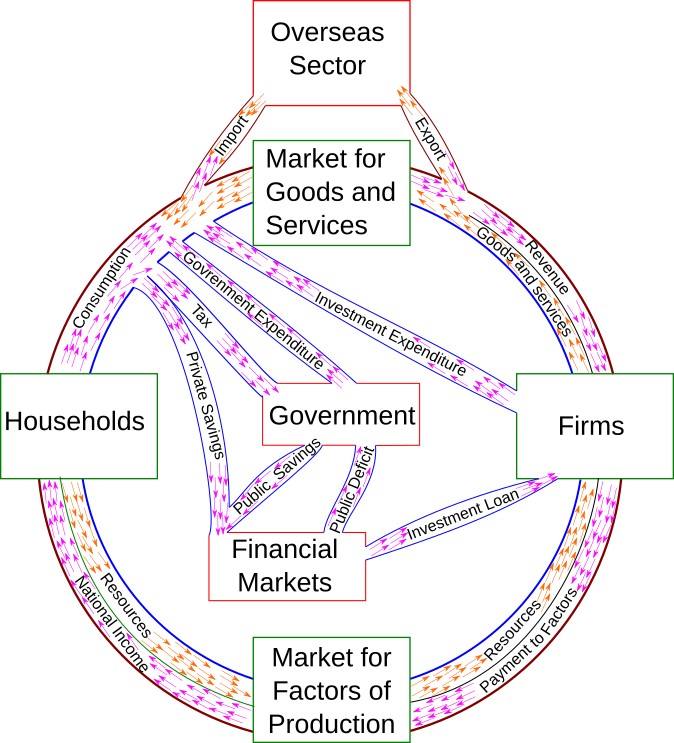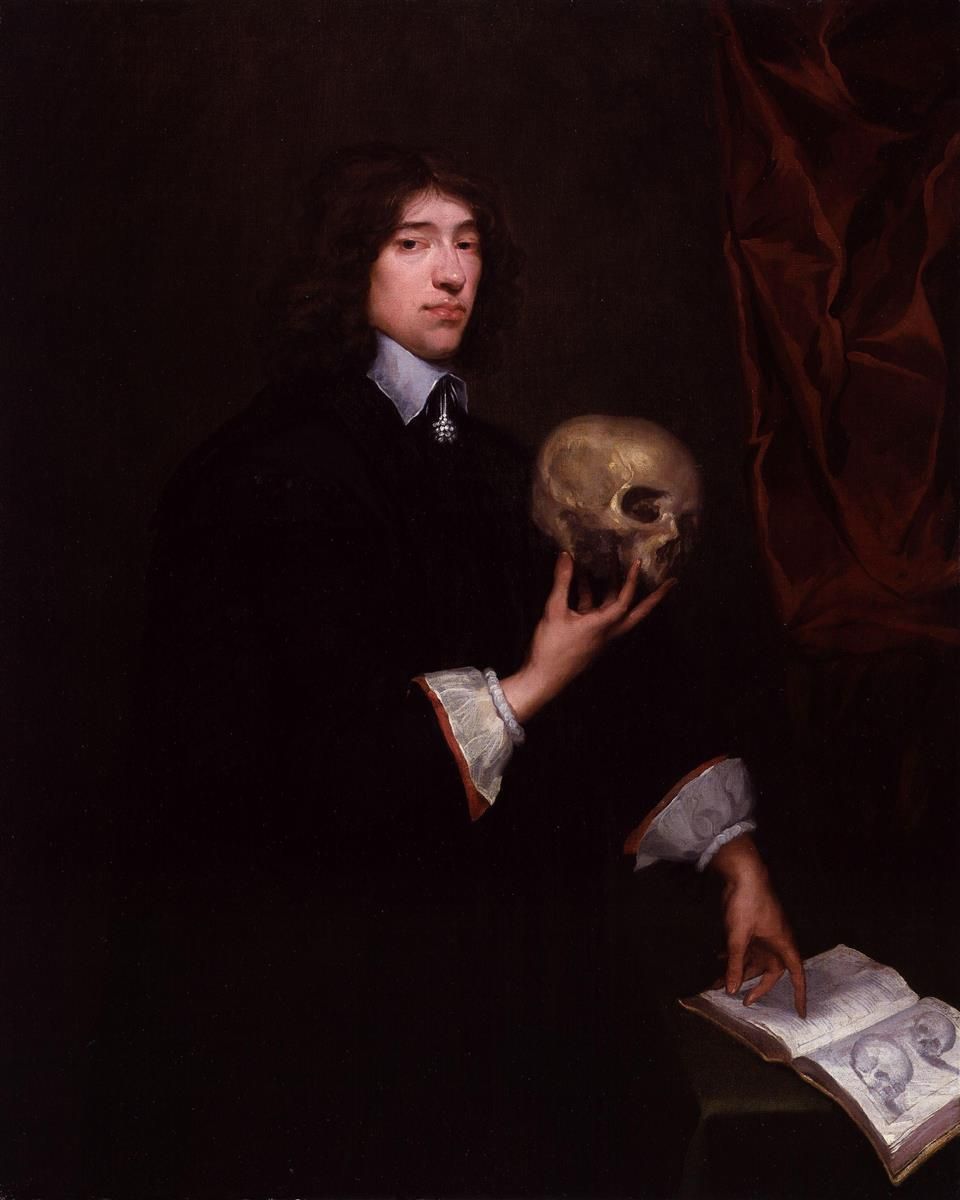|
Circular Flow
The circular flow of income or circular flow is a model of the economy in which the major exchanges are represented as flows of money, goods and services, etc. between economic agents. The flows of money and goods exchanged in a closed circuit correspond in value, but run in the opposite direction. The circular flow analysis is the basis of national accounts and hence of macroeconomics. The idea of the circular flow was already present in the work of Richard Cantillon.Antoin E. Murphy. "John Law and Richard Cantillon on the circular flow of income." ''Journal of the History of Economic Thought.'' 1.1 (1993): 47–62. François Quesnay developed and visualized this concept in the so-called Tableau économique.Backhouse, Roger E., and Yann Giraud. "Circular flow diagrams." in: ''Famous Figures and Diagrams in Economics'' (2010): 221–230. Chapter 23. Important developments of Quesnay's tableau were Karl Marx's reproduction schemes in the second volume of '' Capital: Critique ... [...More Info...] [...Related Items...] OR: [Wikipedia] [Google] [Baidu] |
Richard Stone
Sir John Richard Nicholas Stone (30 August 1913 – 6 December 1991) was an eminent British economist. He was educated at Gonville and Caius College and King's College at the University of Cambridge. In 1984, he was awarded the Nobel Memorial Prize in Economic Sciences for developing an accounting model that could be used to track economic activities on a national and, later, an international scale. Early life and education Richard Stone was born in London on 30 August 1913. He received an English upper middle class education when he was a child as he attended Cliveden Place and Westminster School. However, he had not been taught mathematics and science until secondary school. When he was 17 years old, he followed his father to India as his father was appointed as a judge in Madras. From India, he visited many Asian countries: Malaya, Singapore, and Indonesia. After travelling for one year, he went back to London and then matriculated at Gonville and Caius College, Cambridg ... [...More Info...] [...Related Items...] OR: [Wikipedia] [Google] [Baidu] |
Essay On The Nature Of Trade In General
''Essay on the Nature of Trade in General'' () is a book about economics by Richard Cantillon written around 1730, and published in French in 1755. This book was considered by William Stanley Jevons to be the "cradle of political economy".Jevons 1881, p. 342; writes Jevons, "Cantillon's essay is, more emphatically than any other single work, 'the cradle of political economy.'" Cantillon 2010, p. 15; Editors Mark Thornton and Chantal Saucier write, "The influence of Cantillon's manuscript was largely unknown and the book had fallen so far into neglect that William Stanley Jevons was said to have "rediscovered" it in the late 19th century." Composition and circulation This work remains Cantillon's only surviving contribution to economics. It was written around 1730 and circulated widely in manuscript form, but was not published until 1755. His work was translated into Spanish by Gaspar Melchor de Jovellanos, probably in the late 1770s, and considered essential reading for political ... [...More Info...] [...Related Items...] OR: [Wikipedia] [Google] [Baidu] |
Tony Aspromourgos
Tony Aspromourgos (born 1957-01-11) is an Australian historian of economic thought, professor at the University of Sydney and a Fellow of the Academy of the Social Sciences in Australia (ASSA). He has published several books and many articles in economic journals on different subjects concerning the history of economic thought, especially on William Petty, Richard Cantillon and Adam Smith. Biography In 1978 Aspromourgos did his Bachelor of Economics at the University of Queensland. Three years later, in 1981 he became a Master of Commerce at the University of Melbourne, and in the same year he received his degree as a Master of Arts at the University of Chicago. In 1986, he obtained his Ph.D. at the University of Sydney The University of Sydney (USYD) is a public university, public research university in Sydney, Australia. Founded in 1850, it is the oldest university in both Australia and Oceania. One of Australia's six sandstone universities, it was one of the .... Sinc ... [...More Info...] [...Related Items...] OR: [Wikipedia] [Google] [Baidu] |
William Petty
Sir William Petty (26 May 1623 – 16 December 1687) was an English economist, physician, scientist and philosopher. He first became prominent serving Oliver Cromwell and the Commonwealth of England, Commonwealth in Cromwellian conquest of Ireland, Ireland. He developed efficient methods to survey the land that was to be confiscated and given to Cromwell's soldiers. He also remained a significant figure under Charles II of England, King Charles II and James II of England, King James II, as did many others who had served Cromwell. Petty was also a scientist, inventor, and merchant, a charter member of the Royal Society, and briefly a member of the Parliament of England. However, he is best remembered for his theories on economics and his methods of ''political arithmetic''. He was knighted in 1661. Life Early life Petty was born in London, where his father and grandfather were Cloth merchant, clothiers. He was a precocious and intelligent youth and in 1637 became a cabin ... [...More Info...] [...Related Items...] OR: [Wikipedia] [Google] [Baidu] |
Fixed Asset
Fixed assets (also known as long-lived assets or property, plant and equipment; PP&E) is a term used in accounting for assets and property that may not easily be converted into cash. They are contrasted with current assets, such as cash, bank accounts, and short-term debts receivable. In most cases, only tangible assets are referred to as fixed. While IAS 16 (International Accounting Standard) does not define the term ''fixed asset'', it is often colloquially considered a synonym for property, plant and equipment. According to IAS 16.6, property, plant and equipment are tangible items that: (a) are held for use in the production or supply of goods or services, for rental to others, or for administrative purposes and (b) are expected to be used during more than one period. Fixed assets are of two types: * those which are purchased with legal right of ownership (in the case of property, known as ''freehold assets''), and * those for which the owner has temporary ownership ri ... [...More Info...] [...Related Items...] OR: [Wikipedia] [Google] [Baidu] |
Financial Capital
Financial capital (also simply known as capital or equity in finance, accounting and economics) is any Economic resources, economic resource measured in terms of money used by entrepreneurs and businesses to buy what they need to make their products or to provide their services to the sector of the economy upon which their operation is based (e.g. retail, corporate, investment banking). In other words, financial capital is internal retained earnings generated by the entity or funds provided by lenders (and Investor, investors) to businesses in order to purchase real capital equipment or services for producing new Goods and services, goods or services. In contrast, real capital comprises physical goods that assist in the production of other goods and services (e.g. shovels for gravediggers, sewing machines for tailors, or machinery and tooling for factories). IFRS concepts of capital maintenance ''Financial capital'' generally refers to saved-up financial Wealth (economics), we ... [...More Info...] [...Related Items...] OR: [Wikipedia] [Google] [Baidu] |
Capital (economics)
In economics, capital goods or capital are "those durable produced goods that are in turn used as productive inputs for further production" of goods and services. A typical example is the machinery used in a factory. At the macroeconomic level, "the nation's capital stock includes buildings, equipment, software, and inventories during a given year." The means of production is as a "... series of heterogeneous commodities, each having specific technical characteristics ..." "capital goods", are one of the three types of intermediate goods used in the production process, the other two being land and labour. The three are also known collectively as "primary factors of production". This classification originated during the classical economics period and has remained the dominant method for classification. Capital can be increased by the use of a production process (see production function and factors of production). Outputs of the production process are normally classif ... [...More Info...] [...Related Items...] OR: [Wikipedia] [Google] [Baidu] |
Production (economics)
Production is the process of combining various inputs, both material (such as metal, wood, glass, or plastics) and immaterial (such as plans, or knowledge) in order to create output. Ideally this output (economics), output will be a goods and services, good or service which has value (economics), value and contributes to the utility (economics), utility of individuals. The area of economics that focuses on production is called production theory, and it is closely related to the consumption (or consumer) theory of economics. The production process and output directly result from productively utilising the original inputs (or factors of production). Known as primary producer goods or services, land, labour, and capital are deemed the three fundamental factors of production. These primary inputs are not significantly altered in the output process, nor do they become a whole component in the product. Under classical economics, materials and energy are categorised as secondary factors a ... [...More Info...] [...Related Items...] OR: [Wikipedia] [Google] [Baidu] |
Business
Business is the practice of making one's living or making money by producing or Trade, buying and selling Product (business), products (such as goods and Service (economics), services). It is also "any activity or enterprise entered into for profit." A business entity is not necessarily separate from the owner and the creditors can hold the owner liable for debts the business has acquired except for limited liability company. The taxation system for businesses is different from that of the corporates. A business structure does not allow for corporate tax rates. The proprietor is personally taxed on all income from the business. A distinction is made in law and public offices between the term business and a company (such as a corporation or cooperative). Colloquially, the terms are used interchangeably. Corporations are distinct from Sole proprietorship, sole proprietors and partnerships. Corporations are separate and unique Legal person, legal entities from their shareholde ... [...More Info...] [...Related Items...] OR: [Wikipedia] [Google] [Baidu] |
National Income And Product Accounts
The national income and product accounts (NIPA) are part of the national accounts of the United States. They are produced by the Bureau of Economic Analysis of the Department of Commerce. They are one of the main sources of data on general economic activity in the United States. They use double-entry accounting to report the monetary value and sources of output produced in the country and the distribution of incomes that production generates. Data are available at the national and industry levels. Seven summary accounts are published, as well as a much larger number of more specific accounts. The first summary account shows the gross domestic product (GDP) and its major components. The table summarizes national income on the left (debit, revenue) side and national product on the right (credit, expense) side of a two-column accounting report. Thus the left side gives GDP by the income method, and the right side gives GDP by the expenditure method. The GDP is given on the bottom ... [...More Info...] [...Related Items...] OR: [Wikipedia] [Google] [Baidu] |



